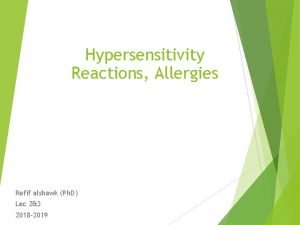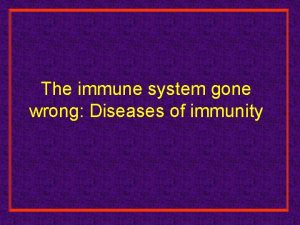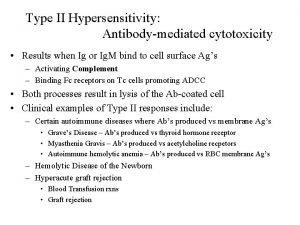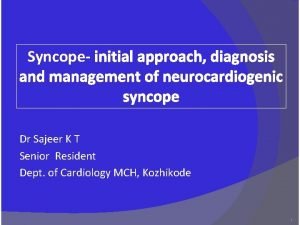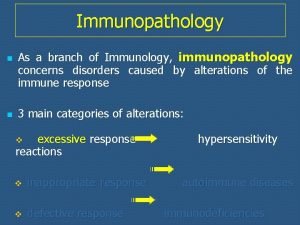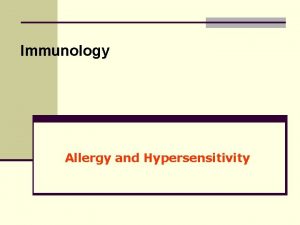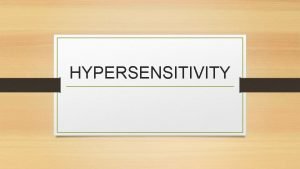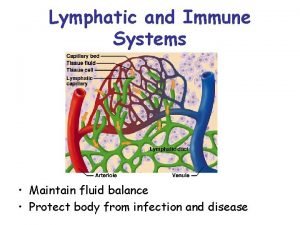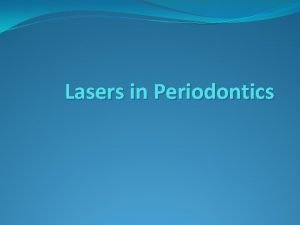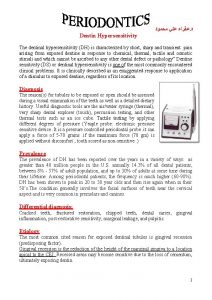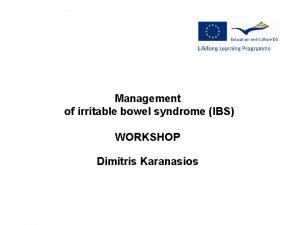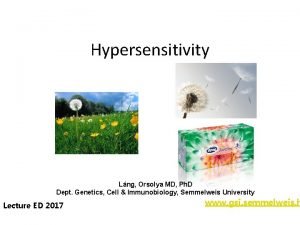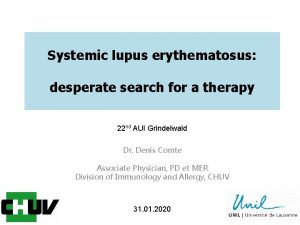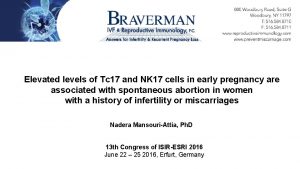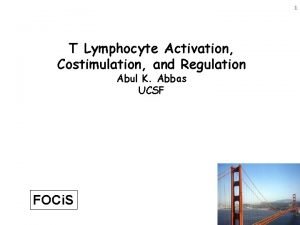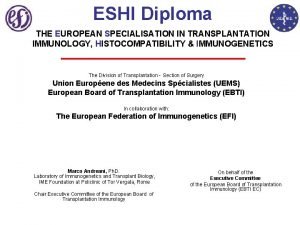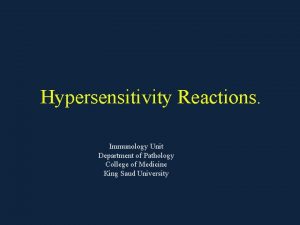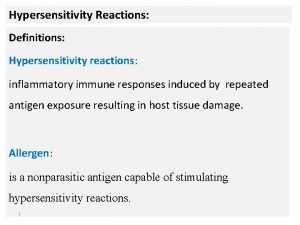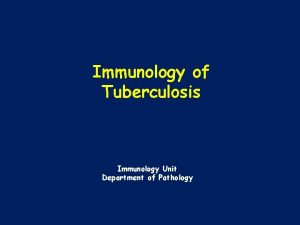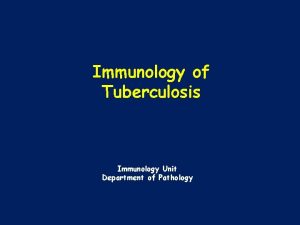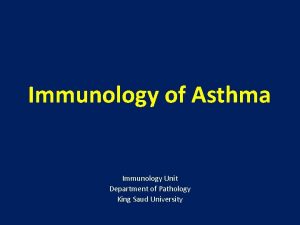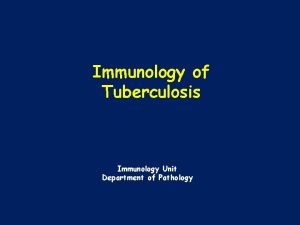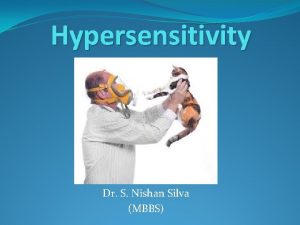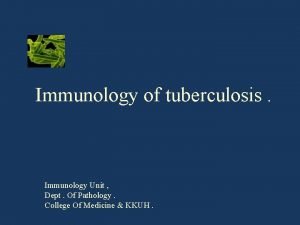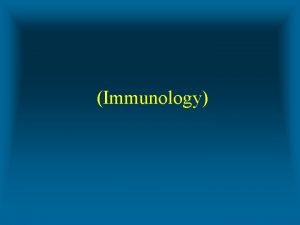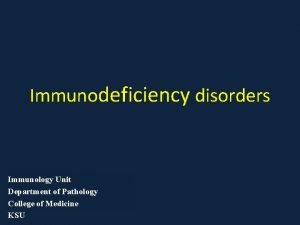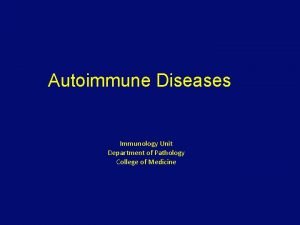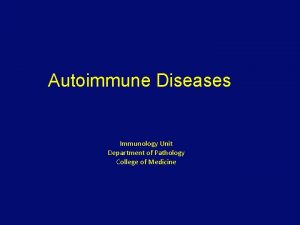Hypersensitivity Reactions Immunology Unit Department of Pathology College
































- Slides: 32

Hypersensitivity Reactions Immunology Unit Department of Pathology College of Medicine King Saud University

Reference Kuby Immunology 7 th Edition 2013 Chapter 15 Pages 485 -510

Objectives • To know that hypersensitivity reactions are over and excessive immune responses that can be harmful to body in four different ways • To be familiar with inflammatory processes in Type I hypersensitivity reaction that mediates allergic inflammation • To recognize that Type II hypersensitivity deals with immune responses against antigens that are integral part of cell membrane and are usually associated with autoimmune disorders • To know that Type III hypersensitivity reactions are mediated by immune complexes and cause vasculitis • To describe Type IV hypersensitivity is a purely cell mediated immune response associated with chronic inflammation

What is hypersensitivity? • Protective immunity: desirable reaction • Hypersensitivity: undesirable reaction • Undesirable responses can be mediated by – Antibody binding to antigens (Types I-III) – Cell mediated reaction to chemicals or proteins (Type IV)

Gel and Coombs Classification Type I: Ig. E Ab Type II: Ig. G Ab to tissue antigens Type IV: Cell Mediated Immunity Type III: Ig. G Immune Complexes

Type I: Immediate Hypersensitivity n n Most people will not react to these allergens but some individuals “atopic” respond by producing large amounts of Ig. E in response to those otherwise harmless substances Non-allergic individuals respond to these allergens by producing Ig. G antibodies

Type I Hypersensitivity • Also termed as: Immediate Hypersensitivity Allergic reactions Anaphylactic reactions are severe and rapidly progressing systemic forms which can be quickly life threatening (Occurs within minutes to hours)

Features - Antibody type: Ig. E - Cellular components: Mast cells, basophiles & eosinophils - Antigens: Also known as allergens (antigens with low molecular weight & highly soluble)

Allergens n Some of the allergens involved in type I hypersensitivity are: pollens, dust mite allergens, animal dander, nuts, shellfish, various drugs etc

Type I reactions occur in two phases • Phase I : - Sensitization phase. First contact with allergens Type I enter Reaction occur in 2 phases: Allergen tissues , induce an immune response. B – cells transform to plasma cells & produce Ig. E. bind to receptors - - Ig. E Challenge phaseon Mast cells and basophiles ( F c ЄRI - high affinity receptors). Subsequent contact allergens individuals becomewith : “ Sensitized. “

Type I Hypersensitivity (Immediate) Sensitization Challenge

Primary and Secondary Mediators 20, 2021 Med 1 12

Allergy is a systemic disorder Nose Esophagus Food allergy Pharynx Lungs Allergic rhinitis Asthma Stomach Skin Eczema Urticaria Allergic dermatitis

Allergy: Rhinitis, Eczema & Conjunctivitis Normal nose

* Injected allergens: Hymenoptera (bees, wasps, ants) sting venom enters the blood stream Systemic inflammation Anaphylactic shock (life - threatening) v Anaphylactoid reactions: Are non - Ig. E mediated may result from contrast media or local anesthetics

Diagnosis of Allergy Skin Prick test 1. Skin prick test (SPT) 2. Specific Ig. E measurement (RAST) 3. Elimination / Provocation test (Food allergy)

Type II Hypersensitivity Reactions • Features: - Ig. G (or Ig. M) - Antigens: bound to cell membranes (Self antigens) - Exogenous antigens (microbial) - Complement activation (Invariable)

Clinical examples: Glomerulonephritis (anti-glomerular basement membrane) Mis-matched blood transfusion

Diagnosis - Detection of antibodies and antigens by Immunofluoresence in tissue biopsy specimens e. g. kidney, skin etc.

Type III: Immune complex hypersensitivity n n When an antigen reacts with an antibody the product they form is called an immune complex which is capable of inducing an inflammatory response Immune complexes are deposited in tissues like kidneys (nephritis), joints (arthritis) or blood vessels (vasculitis)

Type III Hypersensitivity (immune–complex mediated) • Features Antibody (Ig. G/ or Ig. M) + Antigen (soluble) - Immune – Complex formation - Complement activation - Attraction of inflammatory cells

Type III Reactions

Type III Hypers. Reactions Clinical examples: Glomerulonephritis: Rheumatoid arthritis, SLE

Diagnosis of Type III Hypers. Reactions Demonstration of specific immune complexes in the blood or tissues by: Immunofluoresence

Type IV hypersensitivity reactions (Delayed Hypersensitivity) • Features • Cell mediated immune response – Antigen dependent T cell (CD 4 generally and CD 8 occasionally) activation via MHC Class I or II • Activated macrophages • Delayed onset (2 -4 days) • Abnormal cellular response – (Granuloma formation)

Mediators released by TDTH cells

Development of DTH Response Sensitization phase: 1 -2 week period Effector phase: 24 -72 hours Effector cells (activated macs) act non-specifically

Pathophysiology of Contact dermatitis.

Type IV clinical examples: Contact dermatitis TB granuloma (persistent antigen)

Diagnosis (Type IV) 1. Delayed skin test (Mantoux test) 2. Patch test (Contact dermatitis) 3. Lymphocyte transformation test

Skin Patch Test

Take Home Message • 1. Type I (Ig. E), II (Ig. G) and III (Ig. G) hypersensitivity reactions are mediated by antibodies whereas Type IV hypersensitivity reaction is a cell mediated immune response. • 2. Hypersensitivity reactions are undesirable, excessive, and aberrant immune responses associated with disorders such as allergy, autoimmunity and chronic inflammation.
 Types of allergic reactions
Types of allergic reactions Hygiene hypothesis
Hygiene hypothesis Delayed type hypersensitivity reactions
Delayed type hypersensitivity reactions Chemistry unit 5 reactions balancing reactions worksheet
Chemistry unit 5 reactions balancing reactions worksheet Section 2 reinforcement classifying chemical reactions
Section 2 reinforcement classifying chemical reactions 20 examples of redox reaction
20 examples of redox reaction Section 2 classifying chemical reactions
Section 2 classifying chemical reactions Chemical reactions section 3 reactions in aqueous solutions
Chemical reactions section 3 reactions in aqueous solutions Dr. lana schumacher
Dr. lana schumacher Examples of type 2 hypersensitivity
Examples of type 2 hypersensitivity Carotid sinus hypersensitivity
Carotid sinus hypersensitivity Pemphigus vulgaris tombstone
Pemphigus vulgaris tombstone Hypersensitivity personality
Hypersensitivity personality Hypersensitivity types examples
Hypersensitivity types examples Serum sickness hypersensitivity type
Serum sickness hypersensitivity type Innate defination
Innate defination Hypersensitivity
Hypersensitivity Sensitization hypersensitivity
Sensitization hypersensitivity Dermatomyositis hypersensitivity type
Dermatomyositis hypersensitivity type Type 2 hypersensitivity
Type 2 hypersensitivity Dental hypersensitivity
Dental hypersensitivity Dental hypersensitivity
Dental hypersensitivity Visceral hypersensitivity
Visceral hypersensitivity Anaphylactic vs anaphylactoid reaction
Anaphylactic vs anaphylactoid reaction Hypersensitivity definition
Hypersensitivity definition Phagocyte
Phagocyte Lattice formation antigen antibody reaction
Lattice formation antigen antibody reaction Cellular and molecular immunology
Cellular and molecular immunology Delimumab
Delimumab 17 tc
17 tc Abbas basic immunology
Abbas basic immunology Abbas basic immunology
Abbas basic immunology Diploma in immunology
Diploma in immunology
